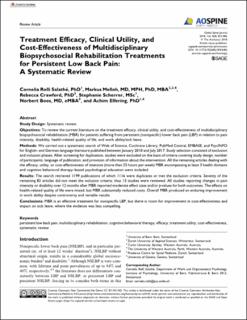Please use this identifier to cite or link to this item:
https://doi.org/10.21256/zhaw-4990Full metadata record
| DC Field | Value | Language |
|---|---|---|
| dc.contributor.author | Salathé, Cornelia Rolli | - |
| dc.contributor.author | Melloh, Markus | - |
| dc.contributor.author | Crawford, Rebecca | - |
| dc.contributor.author | Scherrer, Stephanie | - |
| dc.contributor.author | Boos, Norbert | - |
| dc.contributor.author | Elfering, Achim | - |
| dc.date.accessioned | 2019-01-23T15:39:11Z | - |
| dc.date.available | 2019-01-23T15:39:11Z | - |
| dc.date.issued | 2018 | - |
| dc.identifier.issn | 2192-5682 | de_CH |
| dc.identifier.issn | 2192-5690 | de_CH |
| dc.identifier.uri | https://digitalcollection.zhaw.ch/handle/11475/14578 | - |
| dc.description.abstract | Study Design: Systematic review Objectives: To review the current literature on the treatment efficacy, clinical utility, and cost-effectiveness of multidisciplinary biopsychosocial rehabilitation (MBR) for patients suffering from persistent (nonspecific) lower back pain (LBP) in relation to pain intensity, disability, health-related quality of life, and work ability/sick leave. Methods: We carried out a systematic search of Web of Science, Cochrane Library, PubMed Central, EMBASE, and PsycINFO for English- and German-language literature published between January 2010 and July 2017. Study selection consisted of exclusion and inclusion phases. After screening for duplication, studies were excluded on the basis of criteria covering study design, number of participants, language of publication, and provision of information about the intervention. All the remaining articles dealing with the efficacy, utility, or cost-effectiveness of intensive (more than 25 hours per week) MBR encompassing at least 3 health domains and cognitive behavioral therapy–based psychological education were included. Results: The search retrieved 1199 publications of which 1116 were duplicates or met the exclusion criteria. Seventy of the remaining 83 articles did not meet the inclusion criteria; thus 13 studies were reviewed. All studies reporting changes in pain intensity or disability over 12 months after MBR reported moderate effect sizes and/or p-values for both outcomes. The effects on health-related quality of life were mixed, but MBR substantially reduced costs. Overall MBR produced an enduring improvement in work ability despite controversy and variable results. Conclusions: MBR is an effective treatment for nonspecific LBP, but there is room for improvement in cost-effectiveness and impact on sick leave, where the evidence was less compelling. | de_CH |
| dc.language.iso | en | de_CH |
| dc.publisher | AOSpine | de_CH |
| dc.relation.ispartof | Global Spine Journal | de_CH |
| dc.rights | https://creativecommons.org/licenses/by-nc-nd/4.0/ | de_CH |
| dc.subject | Persistent low back pain | de_CH |
| dc.subject | Systematic review | de_CH |
| dc.subject | Cost-effectiveness | de_CH |
| dc.subject | Treatment utility | de_CH |
| dc.subject | Efficacy | de_CH |
| dc.subject | Cognitive behavioral therapy | de_CH |
| dc.subject | Multidisciplinary rehabilitation | de_CH |
| dc.subject.ddc | 617.5: Orthopädische Chirurgie | de_CH |
| dc.title | Treatment efficacy, clinical utility, and cost-effectiveness of multidisciplinary biopsychosocial rehabilitation treatments for persistent low back pain : a systematic review | de_CH |
| dc.type | Beitrag in wissenschaftlicher Zeitschrift | de_CH |
| dcterms.type | Text | de_CH |
| zhaw.departement | Gesundheit | de_CH |
| zhaw.organisationalunit | Institut für Public Health (IPH) | de_CH |
| dc.identifier.doi | 10.21256/zhaw-4990 | - |
| dc.identifier.doi | 10.1177/2192568218765483 | de_CH |
| zhaw.funding.eu | No | de_CH |
| zhaw.issue | 8 | de_CH |
| zhaw.originated.zhaw | Yes | de_CH |
| zhaw.pages.end | 886 | de_CH |
| zhaw.pages.start | 872 | de_CH |
| zhaw.publication.status | publishedVersion | de_CH |
| zhaw.volume | 8 | de_CH |
| zhaw.publication.review | Peer review (Publikation) | de_CH |
| Appears in collections: | Publikationen Gesundheit | |
Files in This Item:
| File | Description | Size | Format | |
|---|---|---|---|---|
| 2018_Salathe_Treatment_efficacy_clinical_utility_and_cost_effectiveness_of_multidisciplinary.pdf | 321.41 kB | Adobe PDF |  View/Open |
Show simple item record
Salathé, C. R., Melloh, M., Crawford, R., Scherrer, S., Boos, N., & Elfering, A. (2018). Treatment efficacy, clinical utility, and cost-effectiveness of multidisciplinary biopsychosocial rehabilitation treatments for persistent low back pain : a systematic review. Global Spine Journal, 8(8), 872–886. https://doi.org/10.21256/zhaw-4990
Salathé, C.R. et al. (2018) ‘Treatment efficacy, clinical utility, and cost-effectiveness of multidisciplinary biopsychosocial rehabilitation treatments for persistent low back pain : a systematic review’, Global Spine Journal, 8(8), pp. 872–886. Available at: https://doi.org/10.21256/zhaw-4990.
C. R. Salathé, M. Melloh, R. Crawford, S. Scherrer, N. Boos, and A. Elfering, “Treatment efficacy, clinical utility, and cost-effectiveness of multidisciplinary biopsychosocial rehabilitation treatments for persistent low back pain : a systematic review,” Global Spine Journal, vol. 8, no. 8, pp. 872–886, 2018, doi: 10.21256/zhaw-4990.
SALATHÉ, Cornelia Rolli, Markus MELLOH, Rebecca CRAWFORD, Stephanie SCHERRER, Norbert BOOS und Achim ELFERING, 2018. Treatment efficacy, clinical utility, and cost-effectiveness of multidisciplinary biopsychosocial rehabilitation treatments for persistent low back pain : a systematic review. Global Spine Journal. 2018. Bd. 8, Nr. 8, S. 872–886. DOI 10.21256/zhaw-4990
Salathé, Cornelia Rolli, Markus Melloh, Rebecca Crawford, Stephanie Scherrer, Norbert Boos, and Achim Elfering. 2018. “Treatment Efficacy, Clinical Utility, and Cost-Effectiveness of Multidisciplinary Biopsychosocial Rehabilitation Treatments for Persistent Low Back Pain : A Systematic Review.” Global Spine Journal 8 (8): 872–86. https://doi.org/10.21256/zhaw-4990.
Salathé, Cornelia Rolli, et al. “Treatment Efficacy, Clinical Utility, and Cost-Effectiveness of Multidisciplinary Biopsychosocial Rehabilitation Treatments for Persistent Low Back Pain : A Systematic Review.” Global Spine Journal, vol. 8, no. 8, 2018, pp. 872–86, https://doi.org/10.21256/zhaw-4990.
Items in DSpace are protected by copyright, with all rights reserved, unless otherwise indicated.